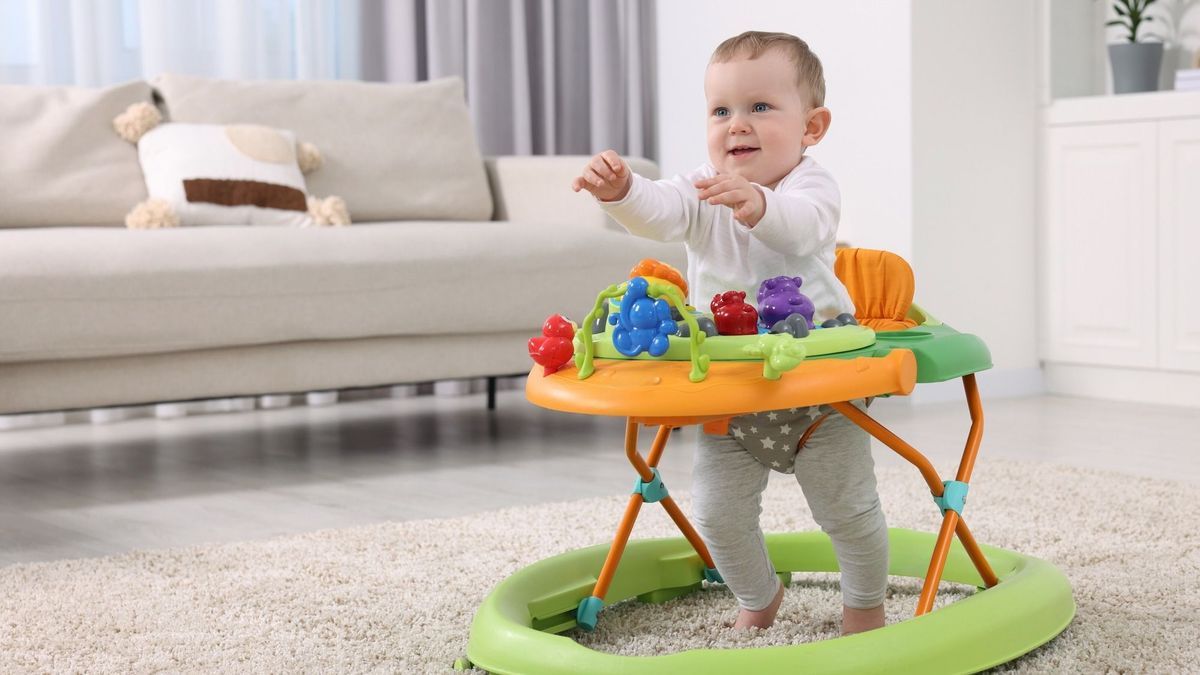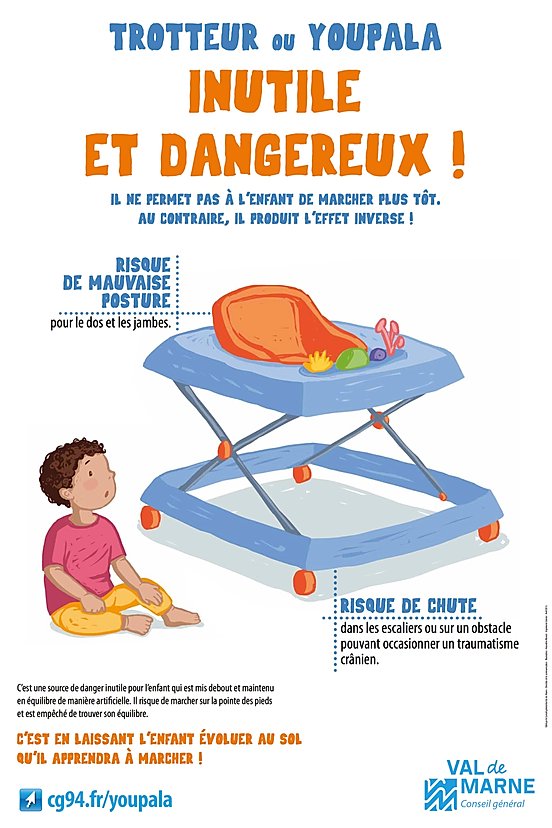
Used by many generations of parents, the youpala or walker is today singled out by early childhood professionals. Is it a useful toy for baby's awareness, learning to walk and psychomotor development? What about security? A psychomotor therapist deciphers the use of the youpala for us.
Among the profusion of childcare articles, flirting with the category of toys, certain objects like the youpala, also called trotter, cross the generations. Essential in the 80s, it is today singled out by many early childhood professionals (pediatricians and psychomotor therapists), who consider it useless and even dangerous. Explanations.
What is the youpala?
In Europe, we find this childcare object, also classified in the baby toys category, in all childcare stores. Chicco, Fisher Price, Young Star, Babymoov… many brands market one or more models of baby walker. Concretely, thehe child sits in a padded seat with his feet touching the ground. He has a tablet in front of him with small educational games and he moves by pushing on his feet.. Small wheels under the frame of the walker allow the machine to move. The base of the frame is a plastic square which will then cushion shocks against walls, doors in the house, etc.
According to the manufacturers, this tool aims to awaken the baby, to take his first steps towards autonomy, while allowing parents to go about their business..
How old is the youpala?
“Parents tend to put their child on the youpala before learning to walk. As an indication, it is done between 10 and 20 months, in general“, explains Sarah Sorano, psychomotor therapist.
Why is the youpala not recommended for babies?
Bad for psychomotor development
“It allows children to move around using their feet to push the ground. However, youpala can cause delays in the acquisition of motor skills such as balance, coordination, muscle strength“, assures our expert before adding: “in addition, the pelvis is frozen and is not mobilized. Prolonged sitting leads to poor posture. The plantar support is incomplete, he will constantly be on tiptoe. Some excess pressure of body weight on the legs leads to problems with muscular and skeletal development“.
In summary, by using the youpala, the baby cannot explore his environment as he wishes. It has a negative impact on overall development.
Not to mention it leads to a reduction in sensory exploration. An opinion shared by Edith, psychomotor therapist in CAMSP (Precocious Medico-Social Action Center) in Burgundy: “the child must make his own experiences of learning to walk with all the stages of discovering support on the ground. His brain maturation will lead him to walking. In a walker, everything is wrong ! The child does not see his feet, he cannot anticipate, he does not learn to use his reflexes, his hands. He cannot mobilize his body, he is hampered, while it is essential to have good support.”
Pro tip : at this age babies need to touch, smell, explore. These at-home and outdoor experiences are important for developing sensory skills and coordination. In short, long live free motor skills!
A useless toy, even dangerous for baby's health
The youpala has been banned for sale in Canada since 2004. In Europe, its use is prohibited among childminders and daycare centers, due to the risk of falls and head injuries. “The speed at which the child moves is very fast, he may also bump into furniture and may end up falling“, confirms Sarah Sorano. Supporting figures, several studies have also pointed out, since the 90s, the dangerousness of the youpala, with an increased risk of falls on stairs, despite warnings and calls for vigilance mentioned on baby walkers, for parents In 1997, a study published in Pediatrics reported 271 children injured over a period of 3 years, 96% of them due to a fall from the youpala on the stairs. average age of victims being 9 months In Europe in the 2000s, a study by the pediatric department of the Faculty of Medicine of Strasbourg showed that baby walkers are responsible for more than 40% of head injuries recorded in children under 12 months, due to a fall down the stairs at home. Another study, carried out in Toulouse from 2003 to 2005, recorded 178 walker accidents, 72% of which were head injuries. For its part, the Val de Marne departmental council carried out an awareness campaign to warn parents and early childhood professionals of the risks linked to the use of the youpala. The message is clear: to develop and grow, your child does not need youpala.
Finally, be aware that the European Association for Child Safety (European Child Safety Alliance) is also campaigning for a ban on baby walkers.

Can the baby walker be used in small doses, under parental supervision?
Questioned on this subject, Sarah Sorano's answer is clear: “lThe walker should be banned and no model is better than another“. So there is no need to waste your time searching on the Internet: where to buy a youpala for baby, what are the purchasing criteria… this toy should be banned for the safety, health and development of baby, whether either on the birth list or as a gift to a child.
What should you replace the baby walker with?
Good news, there are many alternatives. Generally speaking, free motor skills are the key to promoting baby's awakening and development with bare feet. In winter, outdoors, choose soft slippers and/or socks.
Playtime on the floor, on an activity mat
This will allow your baby to move freely, strengthen their muscles and develop their balance naturally. Offer your baby rattles, stackable cubes, sensory balls. “These games will stimulate fine motor skills and coordination“, underlines our expert. Also think about foam structures, to be used under parental supervision.
Carrying
It is also a good alternative recommended by the psychomotor therapist and pediatrician Andreas Werner (expert on the mpedia site and president of the French Association of Outpatient Pediatrics), especially if you need to do something else.
The pusher
Please note, it is not to be confused with the youpala or trotter. It is sometimes called a push walker. The pusher generally comes in the form of a wooden or plastic cart. It can also have the shape of a vehicle with large handlebars. In this case, the baby is active, he is standing on his supports, and pushes on the cart to move forward. This toy is also called an activity cart or walking cart.
The advice of the psychomotor therapist : this pusher should only be used when the child can get into a standing position on their own.
